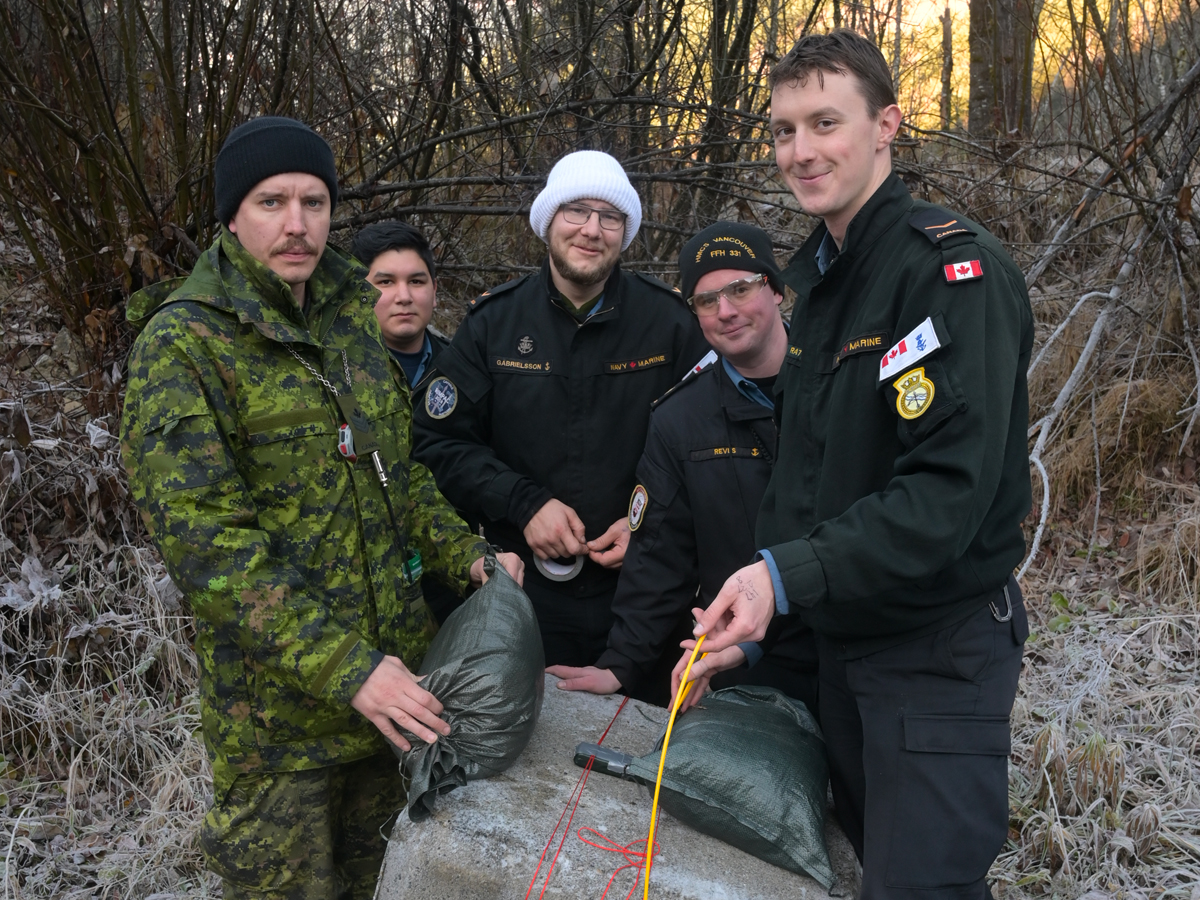Chilliwack trialed for demolition training
By Lookout on Dec 03, 2019 with Comments 0

Petty Officer Second Class Jason Boisvenue, Able Seaman Coree Ranville, AB Adam Gabrielsson, Leading Seaman Joshua Reves, and LS Gregory Ratych pose with their project for the demolition phase of their training. Photo by MCpl Carbe Orellana, MARPAC Imaging Services.
LCdr Michael Erwin, NFS (P) ~
From October into December, Naval Fleet School (Pacific’s) Seamanship Division is conducting three RQ demolitions phases, two RQ Ordinary Seaman serials, and one RQ Leading Seaman serial at Slesse Demolitions Range near Chilliwack on the mainland as a proof of concept designed to gather data and experience about the use of this range.
The usual location for this training is Bentinck Island, located between Pedder Bay and Race Rocks. However, in the fall of 2018 the Bentinck Island Range was temporarily closed, causing NFS(P) to consider other options for the delivery of its demolitions mandate. The possibility that presented itself was the use of Slesse Demolitions Range.
Though the Bentinck range re-opened with no impact to training, the notion of trialing Slesse Range as a venue for demolitions training took hold, so that the various logistical and personnel requirements of the alternate site could be fully understood should the use of Bentinck become unfeasible for any reason in the future.
Getting to Slesse
The research and preparations required to shift the training from Bentinck Island to the unfamiliar and relatively distant Slesse Range were extensive, but under the efforts and leadership of CPO2 John Kranz, PO1 Kevin Hall, and A/SLt Alexandra Duplessis the plan took shape. A host of considerations were thought out and dealt with, ranging from how to move equipment, people, and explosives to the mainland range, to the accommodation and feeding of staff and students.
They took advantage of the military camp established in Chilliwack in 1942. Following unification in 1968 it became Canadian Forces Base Chilliwack. CFB Chilliwack was best known as the home of the CF Officer Candidate School and the CF School of Military Engineering, the latter being the reason for the presence of the Slesse Demolitions Range. In 1997, CFB Chilliwack was closed, and the military footprint there was greatly reduced; the site is now home to the RCMP’s Pacific Region Training Centre (PRTC).
On the ground
During the trials, the Seamanship Division staff, Campus Support Division sentries, and RQ students have been staying at the Mounties’ PRTC facilities. This entails eight days of training for the RQOS and 14 days for the RQLS.
The PRTC is well appointed with accommodations, messing and dining facilities, a gym, and classroom space for the dry land training needed before proceeding to the range for live blasting.
Once the theory is learned, the entire group travel 30 minutes each day from the PRTC to Slesse Range, located in mountainous, wooded terrain south of the Chilliwack River, for the live firing phase.
The students travel in the back of a mobile support vehicle supplied by 39 Canadian Brigade Group, whose headquarters are also located in Chilliwack, and who have been extremely helpful throughout the preparations and execution of the trial.
On the range
Once at the range, the students practice live demolitions with C4 plastic explosives, ranging in complexity from very simple detonations for the RQOS classes, to more complex projects involving the destruction of wood, metal, or concrete targets for the RQLS class. Of course, all the training is subject to strict CAF and range safety rules, and is overseen by skilled instructors with years of combined experience in demolitions operations and teaching.
The need for ranges such as Bentinck Island and Slesse, and for the type of training that is conducted there, lies in the unique capability they provide the ships of the Royal Canadian Navy in dealing with a wide range of situations. Having an organic demolitions capability within their Deck Department enables a deployed ship to safely and efficiently dispose of anything from a floating navigation hazard, such as a hulk or abandoned vessel, to a cache of illicit drugs, or to clear obstructions from a shoreline, as well as provide support to the infantry ashore if required.
About Bentinck Island
Bentinck Island, located between Pedder Bay and Race Rocks, is where the Naval Fleet School (Pacific) (NFS(P)) conducts its demolitions training for all Boatswain Rank Qualification (RQ) serials, as well as Demolitions Team Training for the ships of Canadian Fleet Pacific. Bentinck Island, which served as a leper colony from 1924 to 1952, is well suited to its current role as a demolitions range because of its relative isolation and proximity to the Canadian Forces Ammunition Depot at Rocky Point.
Filed Under: Top Stories
About the Author:





